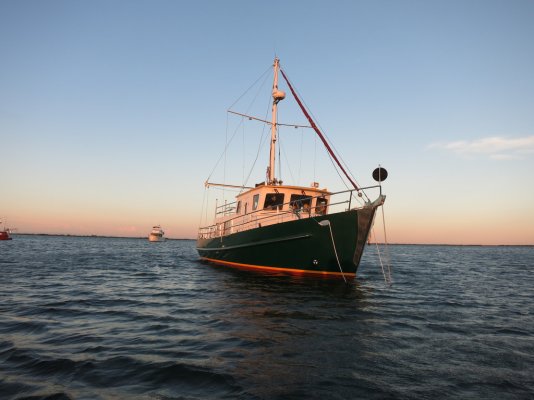A British couple taught me how to take care of situations like this. Whenever someone would come into a port or anchorage and would drop their anchor too close to the anchor of the British couple they would blast the air horn (one of those horns on a cannister of compressed air). He would keep blasting away until the vessel paid attention and would move out of the way. Saw him do it 2 days in a row in a port, worked like a charm.
Out in the anchorage he would do the same, but he would also ask the captain a simple question, in a typical British manner: 'excuse me, but are you sure you can afford to pay the damage in case your boat starts dragging or bumps into mine during the night'. He told me that most people would look strange and bewildered, but in the end all of them would get the message.
Fast forward to an anchorage on the West side of Amorgos about a month ago. We are in a 5 day storm (7 to 8 Bft continuously), have 90 mtr of chain out and tied up with the stern to the shore to keep the bow in the waves. In comes a charter catamaran, just drop their anchor right in front of us, drop the minimum amount of chain, close the boat and go to shore. I sounded my horn, he stuck up his middle finger, so I called him from the bow, he told me to F*ck off.
That was the moment I decided to call the owner of the charter company. Took a while to find his number (that is when starlink comes in handy), called the guy and he actually told me that the captain was his employee, so it was not a bare boat charter. Told him exactly the reaction of his captain and asked the owner if he would pay the damage to my boat, his boat and the environment (had about 2000 liters of diesel onboard with the shore 20 mtrs behind me and a storm blowing us into the shore) if his captain would start dragging through the night in this storm and would pull us into the shore. There was no way I was going to pick up my anchor, release three shore lines in a storm so that his employee could occupy the anchorage.
Answer came quickly. After we hang up he immediately called that captain, guy came over to apologize and he moved the boat. Guy was a disgrace as a captain of a charter boat, his guests must have had a great time with him (not).
Other time we came in late at night in an anchorage near Naxos, so one thing we always do is to ask where the anchors of the other boats are, so we make sure we don't drop on them. We dropped ours, laid out 80 mtrs, but still felt too close, so picked it up, moved to a more open spot in the anchorage (more rocking and rolling), but so be it. Left early in the morning, no harm done to anyone.
Here in de Med in the summer season the amount of charter boats is astounding and many of the people on board don't know how to anchor. They also don't know that the insurance is not going to cover any damage they cause. They think the insurance will simply pay, but the charter companies won't have it. That means that the charter guests themselves are personally responsible for any damage. Good luck trying to chase them in their home countries. Therefore we have to be very alert and assertive when it comes to preventing damage. It is also the reason why we prefer to anchor in deep water. The charter boats don't have that much chain / rope so they cannot anchor in deep water. They will usually huddle and cuddle together, sometimes no more than 10 or 20 mtrs between them. When the wind picks up many start dragging and panic erupts. Then it is good to be as far away as you can.
Luckily the live aboards know how to anchor and they will keep their distance from other boats. And my experience is that, when you enter an anchorage, you ask where the anchors are of the boats closest to the spot you want to anchor, they will be friendly and forthcoming. Also sets a friendly tone and causes less stress for everyone.
I don't know if you have many charter boats in the US, but if you do I can imagine the scenes in the anchorages during the season. Not fun.

